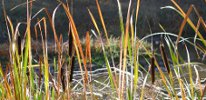
Training
The New Normal: Changed Disturbance Regimes and New Invasive Species
COST: FREE
REGISTRATION FOR THIS PROGRAM IS CLOSED
Instructor Information
Dr. Grey Hayes
CTP Coordinator
Elkhorn Slough Coastal Training Program
Contact
Grey Hayes
ghayes@ucsc.edu
(831) 728-8050
Sponsors
Description
See also: Protected Lands Management, Habitat Restoration
In our explorations of reserve design and why management matters, we have discovered the root of our motivation in expending time and money to manage protected areas: humans have begun pulling apart the ecological fabric that sustains them, and so they must now mitigate that damage by actively managing ecosystems. How much have we changed things in our recent history? This class will explore two of the most fundamental changes- alterations of natural fire regimes and introduction of species from distant lands. And so, we must ask ourselves the following questions:
What were fire regimes before humans altered them?
What role does fire play in our landscape?
Can human ignitions take the place of lightning strikes?
How do invasive species affect natural systems?
How do we prioritize amongst invasive species in our management programs?
Documents and Publications
Contact List
We encourage participants to download the contact list to assist with arranging a rideshare or to get in contact with someone you met at the
workshop. Those interested in sharing a ride to the event are marked on the contact list.
Questions and Answers
Submit a question on this subject and we'll provide an answer. coastaltraining@elkhornsloughctp.org
